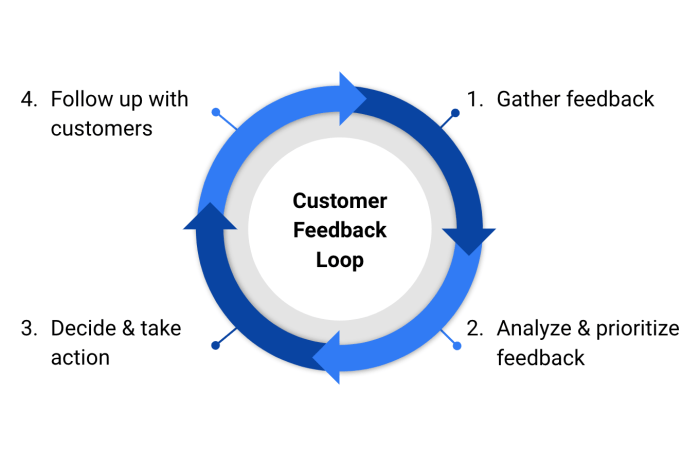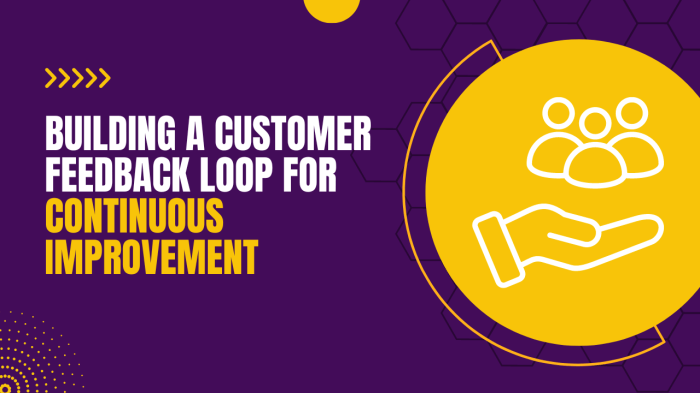Building a Customer Feedback Loop is crucial for companies looking to thrive in today’s competitive market. By understanding the key components and strategies involved, businesses can effectively collect, analyze, and utilize customer feedback to drive growth and innovation.
Understanding Customer Feedback Loop
Customer feedback loop is a process where businesses collect, analyze, and act upon feedback from customers to improve products, services, and overall customer experience. It is essential for businesses to understand customer needs and preferences, identify areas for improvement, and build strong customer relationships.
Establishing a customer feedback loop offers various benefits for companies, such as:
– Improving products and services based on customer input
– Increasing customer satisfaction and loyalty
– Identifying trends and patterns to anticipate customer needs
– Resolving issues and preventing customer churn
Examples of Successful Implementation
- Amazon: Amazon collects feedback through customer reviews, ratings, and surveys to continuously enhance the shopping experience and product offerings.
- Apple: Apple uses customer feedback to innovate new products, improve existing ones, and provide exceptional customer support.
- Square: Square gathers feedback from merchants to enhance its payment processing solutions and develop new features tailored to customer needs.
Building Blocks of a Customer Feedback Loop

Building an effective customer feedback loop requires a combination of key components that work together seamlessly to gather, analyze, and act upon customer feedback. By understanding these building blocks, businesses can improve their products, services, and overall customer experience.
Methods for Collecting Customer Feedback
- Surveys: Sending out surveys to customers through email, website pop-ups, or social media can provide valuable insights into customer preferences, satisfaction levels, and areas for improvement.
- Focus Groups: Organizing focus groups allows businesses to gather in-depth feedback from a small group of customers in a face-to-face setting, providing qualitative data and direct interactions.
- Social Media Monitoring: Monitoring social media platforms for mentions, comments, and reviews can help businesses understand how customers perceive their brand and identify areas of concern or praise.
Analyzing and Interpreting Customer Feedback
- Quantitative Analysis: Utilizing tools to analyze quantitative data from surveys or ratings can help identify trends, patterns, and statistical significance in customer feedback.
- Qualitative Analysis: Reviewing open-ended responses, comments, or feedback from focus groups can provide deeper insights into customer emotions, motivations, and specific suggestions for improvement.
- Action Planning: After analyzing feedback, businesses should develop an action plan to address key issues, make improvements, and communicate changes to customers to show responsiveness and commitment to their feedback.
Implementing Feedback Loop Strategies
When it comes to implementing feedback loop strategies, companies need to follow a systematic approach to ensure effectiveness. Here is a step-by-step guide on how a company can start building a customer feedback loop from scratch:
Step 1: Set Clear Objectives
- Define what you want to achieve with the feedback loop.
- Identify key metrics you want to measure.
- Ensure alignment with overall business goals.
Step 2: Choose the Right Feedback Channels
- Select channels where your customers are most active.
- Consider using surveys, social media, emails, or feedback forms.
- Diversify channels to capture feedback from various touchpoints.
Step 3: Act on Feedback Promptly
- Set up processes to analyze and categorize feedback.
- Assign responsibilities for addressing feedback to relevant teams.
- Implement changes based on feedback received.
Best Practices for Responding to Customer Feedback
Responding to customer feedback is crucial for maintaining trust and loyalty. Here are some best practices to follow:
Acknowledge feedback promptly and express gratitude.
- Personalize responses to show genuine care.
- Address both positive and negative feedback professionally.
- Seek clarification if needed before responding.
- Provide updates on actions taken based on feedback.
Closing the Loop Effectively
Closing the loop involves ensuring that customers feel heard and valued. Here’s how to do it effectively:
- Follow up with customers after addressing their feedback.
- Solicit feedback on the resolution process itself.
- Show appreciation for their input and loyalty.
Tools and Technologies for Automating Feedback Processes, Building a Customer Feedback Loop
Implementing tools and technologies can streamline the feedback loop process. Here are some tools to consider:
Customer feedback software such as SurveyMonkey, Zendesk, or Medallia.
- Feedback analytics platforms for data analysis and visualization.
- Social media monitoring tools to track feedback on various platforms.
- CRM systems to integrate feedback data with customer profiles.
Monitoring and Measuring Feedback Loop Success: Building A Customer Feedback Loop

When it comes to tracking the effectiveness of a customer feedback loop, there are several key metrics and KPIs that can be used to measure success. These metrics help businesses understand how well they are engaging with customers and making improvements based on their feedback.
Customer Satisfaction Score (CSAT)
- CSAT measures the overall satisfaction of customers with a product or service. It is usually obtained by asking customers to rate their satisfaction on a scale.
- Businesses can use CSAT to monitor changes in satisfaction levels over time and identify areas for improvement.
Net Promoter Score (NPS)
- NPS is a metric that measures customer loyalty and likelihood to recommend a business to others. It is calculated based on responses to the question, “On a scale of 0-10, how likely are you to recommend us to a friend or colleague?”
- By tracking NPS, companies can gauge customer advocacy and identify brand promoters who can help drive business growth.
Customer Effort Score (CES)
- CES measures the ease with which customers can interact with a company to resolve issues or complete tasks. It helps businesses understand the level of effort customers need to put in.
- Monitoring CES can highlight areas where processes or services can be streamlined to improve the overall customer experience.
Using Data Analysis to Improve Feedback Loop
Continuous monitoring and analysis of feedback loop data are crucial for making informed decisions and driving improvements. By regularly reviewing feedback, businesses can identify trends, patterns, and areas of concern to take action and enhance customer satisfaction.
Examples of Strategic Decisions based on Feedback Loop Data
- Company X analyzed feedback data and discovered that customers were dissatisfied with the long wait times for customer service. As a result, they implemented a chatbot system to provide instant support, leading to a significant increase in customer satisfaction.
- Company Y used feedback loop data to identify a recurring product issue reported by multiple customers. By addressing the issue promptly, they not only improved product quality but also gained customer trust and loyalty.
